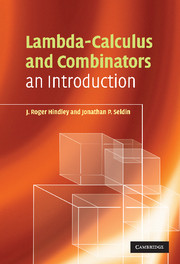Book contents
- Frontmatter
- Contents
- Preface
- 1 The λ-calculus
- 2 Combinatory logic
- 3 The power of λ and combinators
- 4 Representing the computable functions
- 5 The undecidability theorem
- 6 The formal theories λβ and CLw
- 7 Extensionality in λ-calculus
- 8 Extensionality in combinatory logic
- 9 Correspondence between λ and CL
- 10 Simple typing, Church-style
- 11 Simple typing, Curry-style in CL
- 12 Simple typing, Curry-style in λ
- 13 Generalizations of typing
- 14 Models of CL
- 15 Models of λ-calculus
- 16 Scott's D∞ and other models
- Appendix A1 Bound variables and α-conversion
- Appendix A2 Confluence proofs
- Appendix A3 Strong normalization proofs
- Appendix A4 Care of your pet combinator
- Appendix A5 Answers to starred exercises
- References
- List of symbols
- Index
9 - Correspondence between λ and CL
Published online by Cambridge University Press: 05 June 2012
- Frontmatter
- Contents
- Preface
- 1 The λ-calculus
- 2 Combinatory logic
- 3 The power of λ and combinators
- 4 Representing the computable functions
- 5 The undecidability theorem
- 6 The formal theories λβ and CLw
- 7 Extensionality in λ-calculus
- 8 Extensionality in combinatory logic
- 9 Correspondence between λ and CL
- 10 Simple typing, Church-style
- 11 Simple typing, Curry-style in CL
- 12 Simple typing, Curry-style in λ
- 13 Generalizations of typing
- 14 Models of CL
- 15 Models of λ-calculus
- 16 Scott's D∞ and other models
- Appendix A1 Bound variables and α-conversion
- Appendix A2 Confluence proofs
- Appendix A3 Strong normalization proofs
- Appendix A4 Care of your pet combinator
- Appendix A5 Answers to starred exercises
- References
- List of symbols
- Index
Summary
Introduction
Everything done so far has emphasized the close correspondence between λ and CL, in both motivation and results, but only now do we have the tools to describe this correspondence precisely. This is the aim of the present chapter.
The correspondence between the ‘extensional’ equalities will be described first, in Section 9B.
The non-extensional equalities are less straightforward. We have =β in λ-calculus and =w in combinatory logic, and despite their many parallel properties, these differ crucially in that rule (ξ) is admissible in the theory λβ but not in CLw. To get a close correspondence, we must define a new relation in CL to be like β-equality, and a new relation in λ to be like weak equality. The former will be done in Section 9D below. (An account of the latter can be found in [ç H98].)
Notation 9.1 This chapter is about both λ- and CL-terms, so ‘term’ will never be used without ‘λ-’ or ‘CL-’.
For λ-terms we shall ignore changes of bound variables, and ‘M ≡αN’ will be written as ‘M ≡ N’. (So, in effect, the word ‘λ-term’ will mean ‘α-convertibility class of λ-terms’, i.e. the class of all λ-terms α- convertible to a given one.)
Define
∧ = the class of all (α-convertibility classes of) λ-terms,
C = the class of all CL-terms.
- Type
- Chapter
- Information
- Lambda-Calculus and CombinatorsAn Introduction, pp. 92 - 106Publisher: Cambridge University PressPrint publication year: 2008

